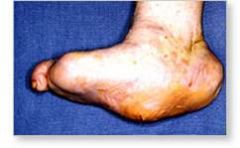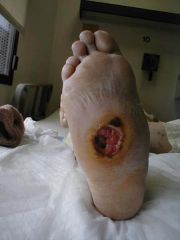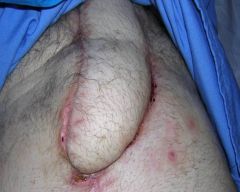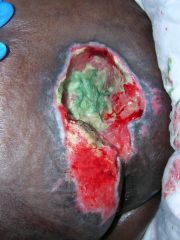![]()
![]()
![]()
Use LEFT and RIGHT arrow keys to navigate between flashcards;
Use UP and DOWN arrow keys to flip the card;
H to show hint;
A reads text to speech;
11 Cards in this Set
- Front
- Back
|
In order to appropriately treat any wound, you must _________________________________, if this is not addressed and corrected, no treatment will be effective
|
Determine the underlying cause
|
|
|
Pressure Ulcers are typically where?
|
-Bony Prominence
|
|
|
Risk Factors for pressure ulcer development?
|
-Impaired circulation
-Decreased mobility -Predisposing illness -Diminished mental capacity -Incontinence -Poor nutrition/dehydration -Past history of pressure ulcers -Poorly fitting splints/braces |
|

What is this ugly thing?
|
Severe Charcot Deformity
|
|

What is this?
|
Typical Ulcer presentation for charcot foot
|
|
|
Traumatic wounds describe a wide variety of causes such as?
|
-Shear Forces
-Gunshot wound -Burns |
|
|
what do exercises address for arterial insufficiency?
|
-Exercise to increase arterial blood flow has been demonstrated to be helpful in long-term maintenance and arterial ulcer prevention
|
|
|
T or F: Therapeutic exercise is one of the most effective measures for patients with claudication
|
TRUE
-It also offers improvements in glucose metabolism, cholesterol levels and cardiovascular benefits. |
|
|
Soft tissue and/or muscle are transplanted from another area of the body or rotated to close a large wound deficit is what?
|

-Flap
|
|
|
What is the difference between a free flap and a rotational flap?
|
Soft tissue and/or muscle are transplanted from another area of the body (free flap) or rotated (rotational flap) to close a large wound deficit
|
|
|
What is important to consider with Sacral pressure ulcers?
|

Muscles around the area of ulceration.
|

